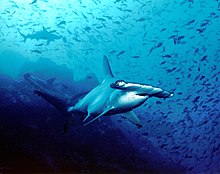
PANAMA CITY, Aug 25 (NNN-TELESUR) — Female scalloped hammerhead sharks (Sphyrna lewini) migrate to Panama’s Bay of Punta Chame to give birth, but are being fished by industrial trawlers in the area, putting the already endangered species a closer risk of extinction, according to a study by the nation’s Secretary of Science, Technology and Innovation (Senacyt).
In a two-year study released on Friday, the Senacyt along with scientists from the Ramsar Regional Center of the Western Hemisphere showed how fishermen are using large nets that capture all types of critical species in the biodiverse, underwater region including other at-risk animals such as rays, along with pregnant and juvenile sharks too young to be legally captured.
(Senacyt) and Ramsar made their joint conclusions by marking with sonar detectors 171 individual sharks and seven rays, as well as tracking 150 fishermen to know where each fished.
Researchers focused on the scalloped hammerheads as they are on the ‘endangered’ species list and because many newborns and youngsters are found in Punta Chame, a small peninsula protected by the Gulf of Panama on the country’s western shores.
The goal of the research is to determine what measures can be taken to protect sharks during the breeding stages and to ensure the fishermen’s livelihoods, marine biologist and professor at the International Maritime University of Panama (UMIP), Yehudi Arriati told EFE.
“We seek to disseminate information among the fishermen about the importance of the site, that it is a breeding area for the female (sharks) that enter the area, and we must manage it carefully” said the shark specialist and Ramsar collaborator.
Arriati explained that the research team marked crowned horned hammerhead sharks (Sphyrna corona), norned spoon (Sphyrna media), pacific weevil dogfish (Rhizoprionodon longurio), which are considered ‘overfished’, and white-faced sharks (Nasolamia velox).
Among the proposals that have been recommended to reduce shark capture are that fishing traulers know the routes through which pregnant females enter and, during that season, reduce the use of mesh longline nets to allow the animals to enter the coastal area.
The researchers are suggesting buoys be placed along these routes to that these tracts of ocean can be avoided. This tactic may also be used for fishermen to avoid these newborn and juvenile marine mammals that are high up on the food chain.
Arriati said that 95 percent of the country’s fishing is carried out along its Pacific coast where Punta Chame is located.
The report, titled, “Characterizing the Biological-Shark Fishing in the Chame Bay Breeding area: Implications for Sustainable Management” also managed to collect the shark species present in the area and the use of habitats of the identified species.
Director of the Ramsar Regional Center, Osvaldo Jordan, told EFE that the study is important because it highlights what can harm these predators that occupy the top of the ocean’s trophic pyramid.
“If sharks disappear it can harm the fishing industry; and people often lose sight of that. We realized there is not much information on their [the sharks’] biology, how much they are fished, their routes and breeding, and this information helps us to talk about that” says Jordan.
Jordan explained that fishermen unintentionally capture sharks, so they believe that an incentive should be implemented to be properly compensated for desirable species and not for these sharks. — NNN-TELESUR





